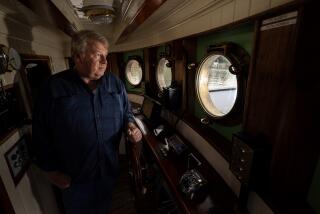Modern-Day Steamboater Plies the Romantic Currents of Twain’s River
ON THE UPPER MISSISSIPPI — Mark Twain once wrote about how the “romance and the beauty” of the Mississippi River vanished when he became a steamboat pilot and learned the river’s dangerous snags and reefs. But Mike Keesee, a modern-day descendant of those old steamboat captains, has been out here more than 20 years and still has not tired of its dark currents.
“The first time I came out here, it was just a job,” Keesee said as he maneuvered his towboat, the Conti-Afton, around a sharp bend in the river. “But once you get out here, it gets in your blood, and it’s hard to get away from. There’s a magnetic thing that draws you back.”
On one beautiful, sun-kissed fall day, it was easy to understand why. Leaves on trees overhanging the banks formed a brilliant kaleidoscope of orange, red and green hues as the tiny Wisconsin town of Fountain City slipped peaceably under the bluffs to the port side. A freight train rumbled through town as the towboat approached.
The Conti-Afton, part of a fleet of towboats and barges operated by Continental Grain Co., was headed to St. Louis, pushing a “tow” of 14 barges, including eight empties and six carrying 11,000 tons of grain intended for export.
Overall, more than half the grain exported from the United States leaves on these covered barges, turning the Mississippi at harvest time into an inland-water highway crowded with dozens of slow-moving steel hulks.
Like truck drivers who rumble along the same interstate year after year, mariners such as Keesee take great pride in knowing every sandbar, every snag, every marker on the Mississippi.
A two-day trip on the Conti-Afton from St. Paul, Minn., to Dubuque, Iowa, offers a rare perspective on Twain’s river and the curious world of riverboat men who live their lives in hermetically sealed isolation between its shores.
Indeed, a taste for solitude seems almost a prerequisite to keeping one’s sanity for the 30 consecutive days that rivermen are supposed to stay aboard before their 15 days off.
The 11-man crew of the Conti-Afton consists of Keesee, a pilot, two engineers, six deckhands and a cook. Theirs is an unsparing routine governed by the relentless changing of the shift every six hours, by food--enough beef, potatoes and other cholesterol-rich food to give most of them ample paunches--and by little rest.
“I’ve never gotten used to sleeping on board,” said Mark Perkins, 32, a deckhand. “I usually sleep about three good hours. You get used to hearing the engines slow down and stop, and then you’re awake. It’s even harder to sleep when you first go home.”
For Keesee and Jack Libbey, the pilot with whom he alternates steering duty, life consists of long hours of isolation in the “wheelhouse,” a small cabin that is far above the water and is equipped with two throttles, radar and other sophisticated modern equipment to guide the tow.
Keesee, 46, of Cape Girardeau, Mo., said the solitude is one of the main attractions of the job. “Up here, I’m alone,” he said. “I have time to think. I never did like working in a factory, where you are around a lot of people all the time.”
Like many captains, Keesee started as a deckhand, a grueling job that involves everything from sweeping and swabbing to assembling and disassembling giant strings of barges so they can make it through locks on the river.
For Keesee, the job was a vehicle to escape life on a General Electric Co. assembly line in St. Louis, and he has made the most of it, learning how to steer from a friendly captain in his free time. Keesee has been piloting towboats since 1974.
Piloting is more difficult than it may first appear, as an outsider quickly realizes when the Conti-Afton approaches one of the locks with which the Army Corps of Engineers keeps the channel navigable.
The lock chamber is 110 feet wide. With three barges wired together side by side and 105 feet wide, the captain faces a tight squeeze bringing his tow through safely, especially when the current is fast and maneuverability is limited.
Mishaps are not common, but they do happen on the Mississippi. Most pilots or captains understandably do not like discussing them, but as Keesee noted, “Anybody who’s been a pilot for any length of time is going to have an accident.” His first occurred years ago, when the front of his tow struck the concrete bulkhead that juts out from a lock and is known as the bull nose.
“The first couple of years you’re pretty nervous,” he said. “It usually takes about four or five years until you get real comfortable up here.”
More to Read
Sign up for The Wild
We’ll help you find the best places to hike, bike and run, as well as the perfect silent spots for meditation and yoga.
You may occasionally receive promotional content from the Los Angeles Times.






